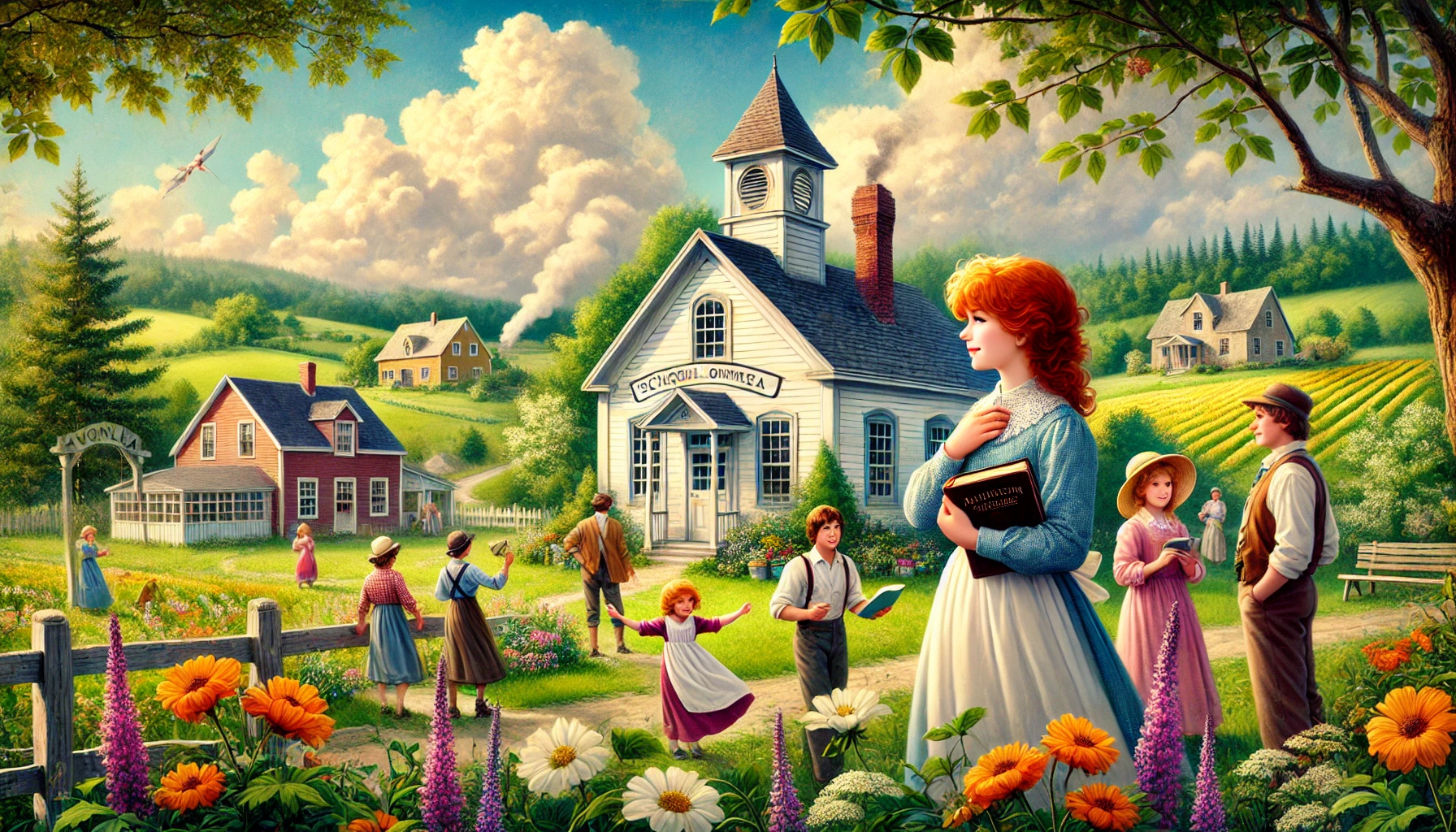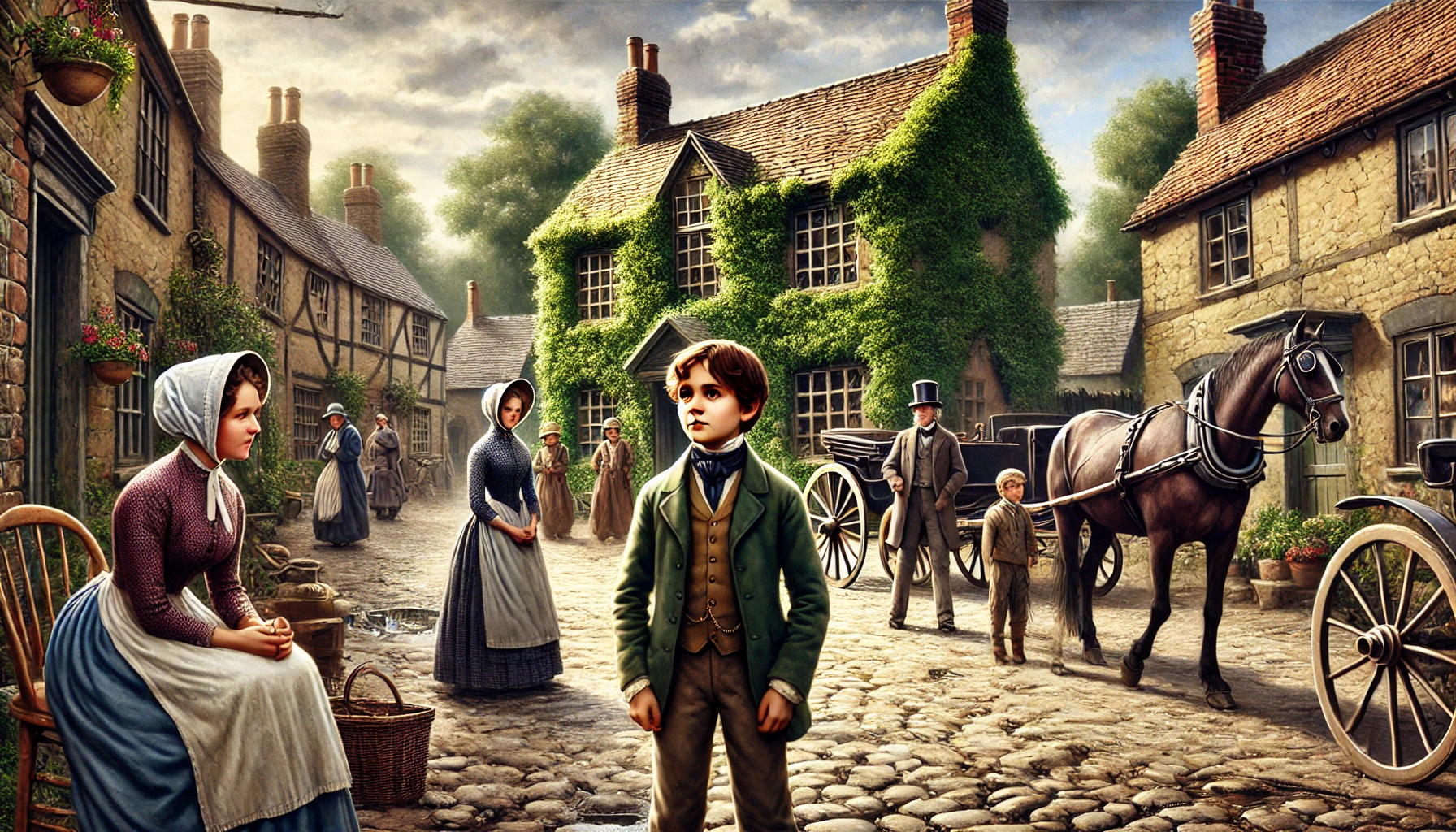“Anne of Avonlea” by Lucy Maud Montgomery, published in 1909, is the second novel in the series following “Anne of Green Gables.” This novel continues to follow Anne Shirley, now a young adult, as she embarks on her journey as a schoolteacher in the small village of Avonlea. The story captures the essence of Anne’s growth, her interactions with the community, and the many challenges and adventures she encounters along the way. Montgomery’s narrative is infused with charm, humor, and the beauty of Prince Edward Island, reflecting both the idyllic and realistic aspects of rural life.
Plot Summary
On a sunny August afternoon, Anne Shirley sits on the doorstep of Green Gables, her heart brimming with dreams of her future as a schoolteacher. Her reverie is abruptly interrupted by Mr. Harrison, a new neighbor who storms into the yard, furious because Anne’s Jersey cow has trespassed into his oat field. This conflict sets the tone for their interactions, with Mr. Harrison perceived as a crank by the community but eventually becoming one of Anne’s unlikely friends.
Anne’s teaching career begins with much anticipation and nervousness. She is excited yet apprehensive about managing her own school at Avonlea. On her first day, Anne stands before her students, trying to remember the speech she had prepared the night before. Despite her nerves, she starts the day by having the children read their Testaments, gradually finding her footing. Her imaginative and kind-hearted nature endears her to her students, though she faces difficulties, particularly with Anthony Pye, a sullen boy determined to resist her. Anne is resolute in her mission to win his affection and treats him with unwavering kindness and understanding, despite his rebellious behavior.
Anne’s life intertwines with the community through various events and personal endeavors. She forms the Village Improvement Society with her friends, Diana Barry and Gilbert Blythe, who teaches at White Sands. They aim to beautify Avonlea, starting with painting the community hall and cleaning up neglected areas. Their efforts reflect Anne’s idealistic vision and relentless spirit, though not without humorous mishaps and resistance from some townsfolk. For instance, persuading Mr. Levi Boulter to demolish his dilapidated house proves to be a formidable task.
Throughout these community efforts, Anne takes on more responsibilities, including helping Marilla Cuthbert with twins, Davy and Dora Keith, after their mother’s passing. The mischievous Davy and the well-behaved Dora bring a new dynamic to Green Gables, testing Anne’s patience and ingenuity. Davy’s antics, such as getting lost or causing trouble at school, contrast sharply with Dora’s obedience, adding both challenges and joy to Anne’s life. Despite the chaos, Anne’s affection for the twins grows, and she becomes a loving figure in their lives.
Anne’s relationship with Gilbert evolves subtly throughout the narrative. Their bond, rooted in deep friendship and mutual respect, hints at a potential romantic connection. Gilbert’s unwavering support and shared enthusiasm for the Improvement Society projects deepen their relationship, leaving readers anticipating further developments in their story.
Amidst her teaching and community projects, Anne also helps her former teacher, Miss Lavendar Lewis, rekindle a romance with Stephen Irving, Paul’s father. This subplot adds a layer of romantic nostalgia and highlights Anne’s matchmaking skills and her deepening understanding of love and relationships. Miss Lavendar, a whimsical and lonely figure, finds happiness again through Anne’s efforts, enriching the tapestry of community connections.
The climax of the narrative revolves around a dramatic incident where Anne rescues the Pye twins from a burning barn. This act of bravery solidifies her place in the hearts of the community and even wins over the stubborn Anthony Pye. Anne’s courage and quick thinking during the rescue exemplify her growth from a dreamy girl into a capable young woman, admired by all.
As the seasons change, Anne’s classroom becomes a place of learning and growth, not just for the children but for Anne herself. She faces the challenges of teaching with creativity and compassion. Her innovative methods, such as storytelling and nature walks, captivate the children’s imaginations and instill a love of learning. Even Anthony Pye, once her fiercest critic, begins to soften under her persistent kindness. The transformation of her students, especially Anthony, is a testament to Anne’s dedication and belief in the goodness within everyone.
The narrative also touches on Anne’s personal reflections and growth. She often retreats to her favorite spots, like the Birch Path and Lover’s Lane, to think about her future and the choices she must make. These moments of solitude reveal Anne’s deep connection to nature and her contemplative spirit. She dreams of further education and travel, but also feels a strong pull towards her home and the people she loves.
By the end of the narrative, Anne has matured significantly. She reflects on her growth, the bonds she has formed, and the lessons learned. Her journey from an imaginative, dreamy girl to a responsible, compassionate young woman is both heartwarming and inspiring. Anne’s unwavering optimism and ability to find joy in the simplest things leave a lasting impression on everyone she meets. Her influence extends beyond the classroom, touching the hearts of all in Avonlea.
Anne’s final thoughts as she gazes over the familiar landscape of Avonlea encapsulate her journey. She realizes that while dreams and ambitions are essential, the true measure of a fulfilling life lies in the love and connections we build along the way. With this newfound wisdom, Anne looks forward to the future with hope and confidence, ready to embrace whatever adventures lie ahead.
Main Characters
- Anne Shirley: The protagonist, Anne is imaginative, kind-hearted, and determined. Her journey as a schoolteacher in Avonlea showcases her growth from a dreamy girl to a responsible young woman.
- Marilla Cuthbert: Anne’s guardian, Marilla is stern but loving. She provides a stable home for Anne and the Keith twins.
- Gilbert Blythe: Anne’s friend and fellow teacher, Gilbert is supportive and shares a deep bond with Anne that hints at a future romance.
- Diana Barry: Anne’s best friend, loyal and supportive, Diana joins Anne in various community improvement projects.
- Mr. Harrison: Anne’s cranky new neighbor who eventually becomes her friend, adding humor and conflict to the story.
- Anthony Pye: A rebellious student who challenges Anne’s patience and teaching methods but ultimately comes to respect her.
- Miss Lavendar Lewis: Anne’s former teacher, whose romantic subplot with Stephen Irving adds depth to the narrative.
- Paul Irving: Stephen’s son, a sensitive and imaginative student who forms a special bond with Anne.
- Davy and Dora Keith: The mischievous and well-behaved twins that Anne and Marilla take in, bringing new challenges and joy to Green Gables
Theme
- Growth and Maturity: Anne’s journey from adolescence to adulthood is central, showcasing her development in responsibilities and emotional maturity.
- Education and Influence: The novel explores the impact a dedicated teacher can have on her students and community, highlighting the value of education.
- Community and Improvement: Anne’s efforts with the Village Improvement Society reflect themes of community spirit and the desire to make one’s environment better.
- Friendship and Love: The evolving relationships, particularly between Anne and Gilbert, and the rekindled romance between Miss Lavendar and Stephen, emphasize the importance of love and companionship.
- Imagination vs. Reality: Anne’s rich imagination often contrasts with the practical challenges she faces, blending dreams with real-world responsibilities.
Writing Style and Tone
Lucy Maud Montgomery’s writing style in “Anne of Avonlea” is characterized by its vivid descriptions, rich imagery, and a warm, engaging tone. Montgomery excels in creating a picturesque portrayal of Prince Edward Island, capturing the natural beauty and charm of rural life. Her narrative is imbued with humor, often highlighting the quirks and idiosyncrasies of the characters, adding a lighthearted touch to the story.
Montgomery’s tone is nostalgic and reflective, often delving into the inner thoughts and emotions of Anne and other characters. This introspective style allows readers to connect deeply with Anne’s experiences and growth. The dialogue is lively and authentic, bringing the characters to life and enhancing the sense of community within Avonlea. Montgomery’s ability to balance lighthearted moments with deeper, more poignant themes makes “Anne of Avonlea” a compelling and heartwarming read.
We hope this summary has sparked your interest and would appreciate you following Celsius 233 on social media:
There’s a treasure trove of other fascinating book summaries waiting for you. Check out our collection of stories that inspire, thrill, and provoke thought, just like this one by checking out the Book Shelf or the Library
Remember, while our summaries capture the essence, they can never replace the full experience of reading the book. If this summary intrigued you, consider diving into the complete story – buy the book and immerse yourself in the author’s original work.
If you want to request a book summary, click here.
When Saurabh is not working/watching football/reading books/traveling, you can reach him via Twitter/X, LinkedIn, or Threads
Restart reading!








